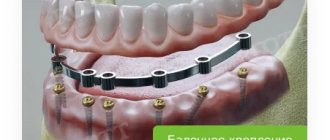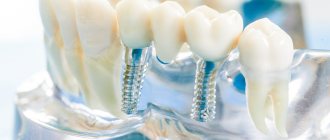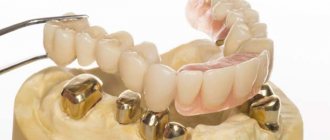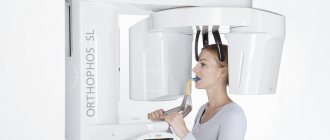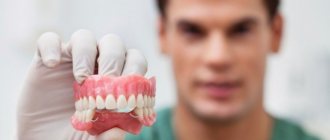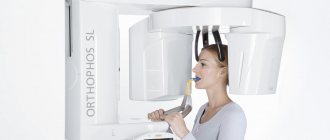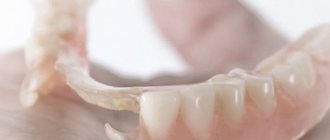HomeOrthopedic DentistryMINI IMPLANTS FOR FIXATION OF PROSTHESIS
MINI IMPLANTS FOR RELIABLE FIXATION OF REMOVABLE DENTURE
Situations when a patient wears a removable denture on the lower or upper jaw occur quite often.
However, when using such an orthopedic design, patients experience significant inconvenience:
- the prosthesis does not fit well in the mouth
- the prosthesis moves when eating and speaking
- the structure rises from its place when chewing viscous food.
Not every patient can afford to make a modern fixed prosthesis on implants using the “ALL-ON-6” or “ALL-ON-4” technology due to their financial situation or due to medical contraindications for health reasons.
The ideal way to carry out high-quality removable prosthetics and get a stationary and securely fixed prosthesis is to install mini implants.
IN THE PHOTO: MINI IMPLANTS INSTALLED IN THE LOWER JAW BONE AND PROSTHESIS ON THE INNER SIDE. DENTIST OZEROV PETER VLADIMIROVICH
Principle of technology
Small implants, smaller models of classic ones, are used as support for a complete removable denture. Their diameter is only 1.8-2.4 mm, and their length is 6-10 mm. They are installed in an atraumatic way - by puncturing the gums, without extensive incisions. Removable prosthetics on mini-implants are carried out even in conditions of jaw bone atrophy - the height and density of bone tissue does not matter, there is no need to build it up.
Immediately on the day of implantation, a removable prosthesis is fixed onto the heads of the implants protruding above the gum , which combines the implants into one system . On the inner surface of each implant there are recesses with metal holders and silicone rings (support points). The fastening mechanism holds the structure and evenly distributes the load between the implants and the prosthesis itself. As a result, the bone tissue is “in working condition,” which stops bone atrophy (loss).
Prosthesis on mini-implants
Installation of a removable denture supported by mini-implants is an express procedure. Installation of implants takes up to 30 minutes depending on their number - 5 minutes for each. Digital impressions are immediately taken and sent to the laboratory. After 2-3 hours, the finished prosthesis is fixed.
Advantages and disadvantages
Microimplants in orthodontics are used to neutralize and eliminate reactive forces, create conditions for teeth immobility and increase reliability. Such structures are indicated as part of complex treatment, when wearing braces, or moving molars. The screws are screwed into the cortical bone, acting as a support and creating conditions for the correct movement of the units. The screws can withstand loads of up to 500 kg, and the rods can be placed in any desired place. At the same time, the skeletal support is reliable, independent, completely unrelated to other elements of the series. Microscrews differ from classical implants in their temporary fixation. After the correction is completed, they are removed.
The dimensions of the rods are:
- length – 7-16 millimeters;
- diameter – 1.4-2 millimeters.
Deviations are allowed if installation conditions, bone condition and other factors require it. The surface is smooth, this structure allows you to perform tasks while preventing fusion and osseointegration. The design solution includes three elements:
- base body of conical-cylindrical or conical shape with thread;
- cylindrical supragingival part with a hole;
- transmucosal ring with a smooth surface in contact with the periosteum and mucosa.
The advantages of using such microimplants include:
- use as part of orthodontic appliances for correction in various clinical situations, including the most complex ones;
- treatment time is reduced, the structure can withstand heavy loads;
- increased reliability and stability of the device is ensured;
- the result is controlled and can be easily predicted;
- there is no need to use extraoral and other types of anchorages;
- reusability;
- adaptation is quick, there is no discomfort or pain.
The disadvantages include increased cost and some installation features. But the effectiveness and shorter correction times justify such shortcomings.
Advantages of prosthetics with mini-implants
Dentures on mini-implants are a low-traumatic, fast and affordable way to restore dentition without additional surgeries and expenses.
- Minimally invasive implantation Miniature implants are installed without incisions in the gums - through a puncture of the mucous tissue.
- No additional operations No need for bone grafting - mini-implants are fixed even with critical bone deficiency.
- Result in one day Dentures are installed immediately on the day of implantation - they are made in the laboratory in 2-3 hours.
- Accelerated rehabilitation Low-traumatic implantation protocol allows you to avoid swelling and pain - recovery in 3 days.
- Ease of use Dentures on mini-implants are less bulky than traditional ones, do not fall out while eating, and do not injure the gums.
- Affordable cost The most budget-friendly option for prosthetics due to the low cost of mini-implants and the lightweight design of the prosthesis.
Prosthetics on mini-implants allows you to reduce the disadvantages of traditional dentures.
Supports in the form of mini-implants improve comfort during use - they allow you to achieve stability and reduce the base of a removable denture, but cannot withstand full loads, like classic implant models.
Levin Dmitry Valerievich Chief physician and founder of the Doctor Levin center
Orthodontic microimplants
Miniature implants are also used in orthodontics to treat malocclusion using braces. Due to the additional support, the pressure force is adjusted based on the patient’s bite defects. They can be installed in the palate of the upper jaw, in the vestibule of the oral cavity, in the alveolar part of the jaw. The structures are temporary and are removed along with the braces. Provides increased efficiency of orthodontic treatment and reduced treatment time.
Application area
- Removable prosthetics The main purpose of mini-implants is to support a removable denture with complete edentia, which improves comfort during its use. The prosthesis is fixed, does not move, no gels are needed for fixation. The structure is reinforced with a metal frame for uniform load distribution and strength, which increases service life. But it cannot withstand strong pressure due to the small size of the supports.
- Temporary prosthetics With classical implantation, especially combined with bone grafting, the implants cannot be loaded immediately; time is required for their healing. In this case, a temporary lightweight prosthesis is attached to mini-implants, which are installed between regular ones. A person can eat normally and not feel aesthetic discomfort. After engraftment of the classic, mini-implants, they are removed and the permanent prosthesis is fixed.
QUALITY REMOVABLE PROSTHETICS AT AN AFFORDABLE COST IN A PREMIUM CLASS CLINIC
Price of a removable denture according to the STANDARD OF THE RF MINISTRY OF HEALTH
and mini implants for its fixation
from 78,000 rubles*
*subject to the installation of a prosthesis on 3 MINI IMPLANTS using an interest-free installment plan for 24 months with an initial payment of 30 percent. The first payment is 78,000 rubles, then 24 months at 8,000 per month. The installment plan is arranged at the clinic. This is not a public offer. Specialist consultation is required.
IN THE PHOTO: CLINICAL CASE OF TOTAL PROSTHETICS WITH COMPLETE ABSENCE OF TEETH USING MINI IMPLANTS FOR FIXING A REMOVABLE DENTURE. DENTIST OZEROV PETER VLADIMIROVICH
How many implants are needed if there are no teeth?
To create a stable support for a removable denture with complete edentia, it is recommended to install:
- on the lower jaw - 4 mini-implants
- on the upper jaw - 6 mini-implants
The difference in quantity is due to the physiologically lower density of the maxillary bone.
Installing a smaller quantity will lead to improper load distribution and failure of the structure.
In order to reduce the cost of treatment, some clinics also install two mini-implants under a full-fledged prosthesis. They are installed in the anterior section, and the chewing areas remain without any fixation. But this is not the best option. When chewing, the denture will move and create a lever effect on the implants. It is easy to guess that the structure will fail very quickly. The initial savings will result in even greater costs in the future.
Chashchin Kirill Valerievich
Orthopedic dentist, 14 years of experience
Virtuoso of prosthetics on implants. Competent planning and diagnostics, creation of comfortable prostheses taking into account individual parameters.
More about the doctor
How to quickly and easily carry out treatment before implantation
Those who have not previously thought about treatment with an orthodontist are not motivated to wear braces, and this is understandable. But now, thanks to aligners, it is possible to undergo treatment in a short time. In addition, such an orthodontic system is invisible to others. Aligners are superior to braces in most important parameters and are best suited for preparation for implantation, since treatment with them is quick.
Preparation for implantation can take from several months to a year, depending on the initial situation. But such comprehensive treatment will bring benefits in the future, since with a correct bite it is easier to maintain healthy teeth.
It is better to correct the bite as early as possible. But if this does not work out, then you can contact an orthodontist at any age, even at 45–50 years old and later (nowadays older patients are not uncommon).
Stages of installing dentures on mini-implants
Preliminary diagnostic and preparatory measures are carried out - this stage determines the success of the entire treatment. In our Center, the treatment plan is drawn up by an orthopedist after analyzing a computer examination and a functional study of the bite. It is the orthopedist who calculates the required number of implants and fixation points on the jaw to evenly distribute the load and ensure proper closure of the teeth after prosthetics.
The prosthetic process itself takes place in one visit; you will receive new teeth in 3-4 hours without leaving the walls of the Center .
- Mini-implantation It is carried out in a minimally invasive way. Punctures are made in the gums, miniature holes are formed in the bone, into which the implants are screwed. It takes only 5 minutes to install one implant
- Prosthetics Using an intraoral scanner, digital impressions are taken and sent to the laboratory electronically. Production in our Center is automated. After 2-3 hours, the finished prosthesis is attached to mini-implants
Mini-implantation is a gentle, low-traumatic technology; local anesthesia is usually sufficient. For anxious patients, we offer implantation in medicated sleep - without fears or nervous shock.
Where to go for installation of mini implants
The table below shows dental clinics offering mini-implant installation services.
| dental clinic | Website |
| Center for Dental Implantology ROOTT (RUTT) | https://dentalroott.ru |
| Adent dentistry | https://www.adent.ru |
| Dantistoff | https://dantistoff.ru |
| The president | https://www.prezi-dent.ru |
| Center Family Dentistry | https://family-dental.ru |
Rehabilitation period
Mini-implantation is a minimally invasive procedure, so recovery is easy and without much discomfort. After a week, all the unpleasant sensations go away. In case of individual predisposition, slight swelling is possible. For such a case, our Center provides a complex of accelerated rehabilitation. Prevents facial swelling and relieves pain.
Getting used to dentures with mini-implants is much easier and faster than with conventional removable ones - adaptation takes only 2-3 days due to the reduced size of the base.
Types of pathologies and the possibility of installing implants
When the bite is imbalanced, the teeth are in the wrong position in the row or the jaws are misaligned. For each clinical case, a treatment regimen is developed:
The degree of inclination is assessed. If dental roots or crowns do not interfere with the implantation, the operation is performed without alignment. This option is for people who do not have maximum aesthetic requirements. But to achieve a perfect smile, orthodontic treatment will be required before implantation. If the roots of adjacent teeth interfere with the installation of implants, orthodontic treatment must be prescribed. Sometimes doctors resort to surgical removal of “eights” that occupy the wrong position in the jawbone.
The degree of anomaly is assessed. If the displacement is insignificant, implantation is possible - the pathology is eliminated using prostheses on implants. If there is a pronounced displacement, implants cannot be installed; it is impossible to achieve a high-quality result.
Life time
With proper care, the removable structure on mini-implants lasts about 5-7 years . Miniature supports are not able to withstand heavy loads for long, so they gradually become loose.
As a quick way to restore teeth on a limited budget, this is a good option. But if you think about the longer-term result, it is better to use standard implants for supports with a lifetime guarantee. The risks of bone tissue atrophy around even four mini-supports are always higher than when using two or three classic implants.
Contraindications for installation
As with any dental structure, the following contraindications exist for mini-implants:
- general contraindications to surgical interventions (blood diseases, pathologies of the heart and blood vessels, respiratory disorders, after radiation therapy for cancer, etc.);
- progression of secondary decompensated immunodeficiency with the development of infectious processes;
- complicated diabetes;
- various types of pathological addictions (alcoholism, smoking, drugs);
- Alzheimer's disease.
Alternatives and comparison of implant prostheses
If you choose from the possible options for removable prosthetics, prostheses on mini-implants are a middle option between traditional prostheses and those fixed to classic implants
| Regular removable | On classic implants | On mini-implants |
| Dimensions are bulky | Reduced sizes | Reduced sizes |
| Getting used to it up to a month | Getting used to it 2-3 days | Getting used to it 2-3 days |
| Reliability of fixation fall out, shift | Reliability of fixation securely fixed | Reliability of fixation deteriorates over time |
| Effects on gums: soreness, inflammation | Impact on gums is minimal | The impact on the gums is minor |
| The risk of bone atrophy is high | The risk of bone atrophy is moderate | Above average risk of bone atrophy |
| Strict dietary restrictions | Minimal dietary restrictions | Average dietary restrictions |
| Requires removal for maintenance after every meal | Need to remove for maintenance 1-2 times a month to clean the fasteners | Need to remove for maintenance once every 2-3 days to clean the fasteners |
| Service life up to 5 years | Service life from 10 years | Service life 5-7 years |
As can be seen from the table, removable dentures with classic implants are advantageous, but also have disadvantages. The only effective and long-term alternative is a fixed full denture with 6 traditional implants or a segmented denture with 8 implants. Such dentures consist only of a series of dental crowns without artificial gums and look as natural as possible. They do not need to be removed for maintenance. And most importantly, they completely stop bone tissue atrophy and even promote its restoration.
Indications – when orthodontic implants are installed
Above, we have already figured out why orthoimplants are placed, and we have found out the main reason for their installation - to increase traction and to avoid the need to remove teeth in case of complex anomalies of the dentofacial apparatus. The main indications for the use of such structures are listed below:
- when it is necessary to correct a rather complex defect, for example, a distal bite, crowding or severe curvature of teeth is diagnosed,
- when the front incisors or molars protrude strongly forward,
- in order to free up space for unerupted fangs,
- if with the help of braces alone it is impossible to provide the required degree of impact on the row,
- if you want to speed up the treatment process,
- if you need to slightly change the size or even position of your jaw,
- if wearing a brace system for a long time does not give the desired results.
The decision on the need to install orthodontic implants is made by the attending physician - an orthodontist, but only after discussing with the patient all possible alternative options. In any case, there is no need to worry about this, since the implantation procedure is carried out minimally invasively and under anesthesia - patients do not experience any significant pain or discomfort. The installation is no longer carried out by an orthodontist, but by a dental surgeon or maxillofacial surgeon or implantologist.
What to do if the implant is already in place
After implantation, the bite cannot be corrected without complex medical procedures. Artificial roots, unlike natural ones, are absolutely motionless. When trying to correct the position, only your own teeth will change. The implant will remain in its original position. The person is faced with a difficult choice. With a radical approach, the artificial root is removed, bite deviations are corrected, then the implant is reinstalled and loaded with a crown. The second option is to ignore aesthetic or functional defects. Sometimes doctors install implants before correcting the bite as part of the treatment plan. After complete engraftment of the metal root, orthodontic treatment begins. With this arrangement, the teeth are attracted or repelled from a fixed support. All stages of therapy are thought out in advance. The scheme must be clearly developed by the implant surgeon together with the orthodontist.
